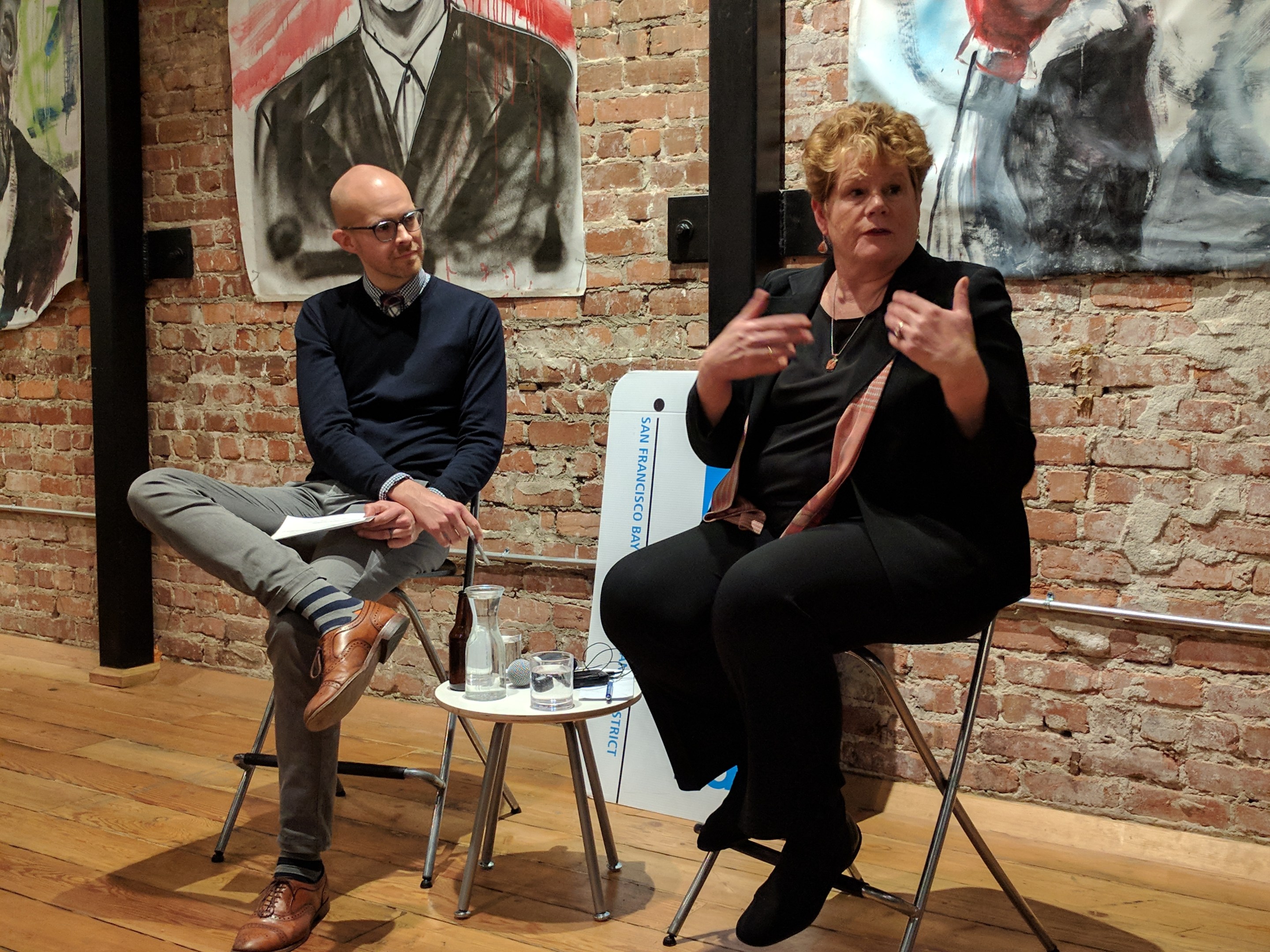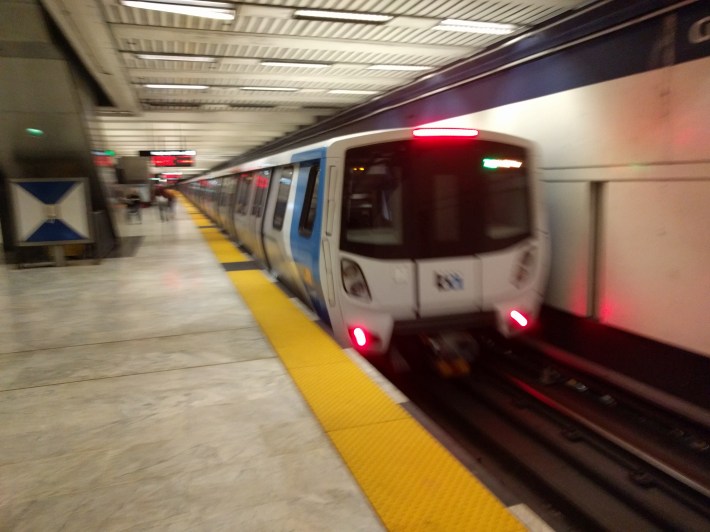SPUR Talk: How to Run a Railroad
3:36 PM PST on February 21, 2019

SPURs Noah Christman and Grace Crunican discuss the future of BART. Photo: Streetsblog/Rudick
Note: GJEL Accident Attorneys regularly sponsors coverage on Streetsblog San Francisco and Streetsblog California. Unless noted in the story, GJEL Accident Attorneys is not consulted for the content or editorial direction of the sponsored content.
Grace Crunican, 64, started in Portland, worked in government and transportation in Washington D.C. and was director of the Department of Transportation in Seattle. In 2011, she took the helm of one of the nation's busiest transit systems: Bay Area Rapid Transit. Now she oversees 3,600 full-time employees and $40 billion in transportation infrastructure.
On Tuesday evening she sat down with SPUR's Noah Christman, as part of its Drinks and Discourse series, to discuss how she came to her role at BART, its challenges, and what Bay Area transit riders can expect to see in the future. Here are highlights from that conversation.
***
Noah Christman: First, and I ask everyone this, tell us where you're from?
Grace Crunican: I was born and raised in Beaverton, Oregon. It’s ten miles in to Portland. In high school, I got an internship with the mayor of Portland, Neil Goldschmidt. He changed the city of Portland when I was a kid by withdrawing a freeway and using the money to build light rail. I was inspired and invigorated by the planners. And I took citizen complaint calls on the transit malls.
NC: So you're no stranger to complaints? What next?
GC: I did my undergrad in political science and criminal justice.
NC: How did you get back into transportation?
GC: I went to Washington, D.C. on an internship program... I took a rotation to the appropriations committee for transportation. Then I came back and worked for the city of Portland. Later I went back to D.C. to run the Surface Transportation Policy Partnership... then ran Oregon DOT, then Seattle DOT--
NC: And now BART. What does your day-to-day look like?
GC: It’s meeting to meeting to meeting. But once a week I go out on the line for an hour or for 45 minutes and talk to the customers. I ask how often do you ride BART? How safe do you feel? Do the escalators work? Then I meet with my managers all the time. Some politicians, oftentimes staff, people who are natural allies of BART, and people who have problems with BART. I get at least one call from a board member every day. The clock stops at some point and I get to go home.
NC: I'm fascinated by time you spend on the system talking with people. What do you hear?
GC: Frustrations... we get a lot of compliments. We have surveys, but if you don’t get out you don’t get a feel, don't get to know the shops and the customers and get a sense of why they're frustrated. Sometimes I'm ahead of what a satisfaction surveys will tell me. Our satisfaction is down because of the cleanliness.
NC: It’s a big system. Do you have numbers in your back pocket to give context of the expanse?
GC: We’re 120 miles. We have over 400,000 riders per day. We have 48 stations. We’ve extended ten miles out to Antioch, five miles to Fremont, Oakland Airport. But mostly on my watch we’ve tried to get the board to look at what needs to be done to sustain the system rather than expand.
NC: Where does your job end and the directors' start?
GC: Their job is to set policy. Mine is to run the agency. My job is to translate the agency to the board and the board to the agency.
NC: I've heard a surprising fact--the average age of the workforce for AC transit is 48, with 26 percent eligible to retire next year. That poses a major problem if those groups chose to go into retirement. What training programs have you put in place to ensure you don’t have a gap in your work force?
GC: Our average age is actually starting to trend downward. But we have critical positions that are a problem--our train operators, the technical guys and gals, the track workers are hard to find. Electricians are hard to find and keep. Elevator workers are very hard to keep. We train them and then they go to work for UC Berkeley and get paid more... so we train them and they get a better job someplace else.
NC: That's the problem, people going off to get other jobs?
GC: (Nods) Police are another category that’s tough. We just increased their salaries. We do our best to be competitive for workers. We’re designing career paths for every category of worker we’ve got, so they see a future at BART. But our pay is normalized to the Bay Area and we have an excellent benefits program. (Turns to audience) If you’re interested in working at BART, I’ll see if I can work you in.
NC: What’s the greatest challenge the BART system faces?
GC: Infrastructure. Understanding that rails need [to be] replaced. We're now replacing 90 miles of rails and one-third of the electrical system under measure RR. I was impressed people responded and were willing to re-invest. We're going to be continuing that work. And we're going to need another measure in a few years.
NC: What else?
GC: The other critical issue is the homeless, the mentally ill, and the drug addiction problem. They come on BART, they spend their day on BART... when I started raising this issue a board member said, 'It’s not a crime to be homeless.' That kind of represented the feeling on the board, say four years ago. But now customers are saying 'I’m leaving BART because it smells bad, nobody is policing.' So now we’re asking what can we do to be respectful of all folks and still manage to make BART a decent place to be. That problem is squarely in front of us. And when I talk with customers, some want more police, some want more BART ambassadors. Tension lingers because of the killing of Oscar Grant. We're still wrestling with that. Our officers now go through crisis incident training, which is more than the average police force does. We're trying to get the police to walk the trains. Most people, for the most part, say they still want to see the police. But about five percent, mostly African-American males, will say, 'I don’t feel safe when I see a police officer.'
NC: What’s the system's greatest asset?
GC: The reason people keep riding BART is because we show up, on time, and the trip is predictable. If you jump on the bus or your car, it’s stuck in traffic. If you jump on BART it’s a 22-minute trip on Wednesday, a month from now, it’s still 22 minutes.
NC: Who's not riding the system?
GC: We have men and women, people of all color--64 percent are people of color. Lots of people who have all different jobs, so 20 to 25 percent are below the poverty level. If you compare that with AC Transit or VTA, it's more like 90 percent. So there are some very wealthy people who probably don’t ride BART, but we have some wealthy people who do, too.
NC: How do you draw new riders?
GC: We have people who are leaving BART because of crime. We had the murder of Nia Wilson, and we had two other incidents--some people panicked and left BART. But crime is actually down on BART. The new cars will be very successful at bringing in new customers. I’ve been in some stations when the new train comes in people go like this (applauds).
NC: I went to a destination just so I could ride it. Uber is eating into ridership. Autonomous vehicles are on the horizon. Is there a potential partnership between AVs and public transit that can be struck in the future?
GC: We have worked with Uber and Lyft. And we will with AVs. There may be a system that circulates in the suburbs. You could have one in Walnut Creek, for example. That would let us use more land at the stations that is now for parking. But even with AVs, nobody’s going to punch another lane through the Caldecott Tunnel. At some point, road capacity is road capacity whether I’m driving or it's an AV. On BART, I have the exclusive right of way.

NC: If you could go in a time machine and go back and change one thing on BART, what would it be?
GC: I would go underground as much as possible. I think Oakland screwed themselves by not doing more underground. I would also have standard gauge. Standardization in the rail industry is a good thing.
NC: Have you heard the description that BART cars make a noise like a steel banshee gargling chainsaws?
GC: Have you been on BART lately? We’re changing the wheel profile. And grinding rails to address that.
NC: Where do you look for best practices?
GC: I send executives to Tokyo, Hong Kong, Singapore and look at what is being done over there. When we look at the benchmarks, Tokyo kind of wipes us all out. What they do differently is train, train, train. But it you compare us to systems here [in the U.S.] by miles between breakdowns, hours between breakdowns, we’re kind of top of class. Again, it's not Tokyo, but we're trying to set benchmarks that would get us there.
NC: Shall we do some word association?
GC: Okay.
GC: Not BART's!
NC: Lyft and Uber.
GC: Potential allies.
NC: Expansion.
GC: Okay.
NC: Fare evasion.
GC: Terrible.
NC: Mega-region.
GC: Don't deny the reality. You can't stop it.
Crunican also took questions from the audience... one person asked about a second Transbay crossing.
GC: It’s exciting to me. We’re working with standard gauge folks on the Capitol Corridor at a project that is maybe BART on top, standard gauge on the bottom. We’re trying to design a process that involves other public jurisdictions that will be involved because it will be bigger audience--who will pay for it? Not just BART. Will it be something that will go close to the existing BART tube, maybe hit Jack London Square, Alameda, go over to San Francisco and intersect at Powell, Civic Center? Open up South of Market? Where it goes from there depends on San Francisco.
Another asked about long headways at night and on weekends.
GC: Trains need to be rehabbed on the weekends and we don’ t have enough of them not to reduce services. I’m with you though--15 minutes is the absolute longest anyone should wait, but 10 is minutes is better. I think as the new cars come in, we'll get to 12-minute headways by 2024 or 2026, at the latest.
***
This interview was edited.
For more events like these, visit SPUR’s events page.
Stay in touch
Sign up for our free newsletter
More from Streetsblog San Francisco
Weekend Roundup: Bancroft Lane Gets Concrete, Party in Downtown S.F.
...and the Bay Bridge to get its lights back
Richmond-San Rafael Bridge Bike Lane Will Need Support
There's no evidence the bike lane contributes to congestion on the bridge
Update on Oakland DOT’s Lakeshore Protected Bike Lane Project
Public seems fairly positive and accepting towards the coming project. Let's hope it stays that way




